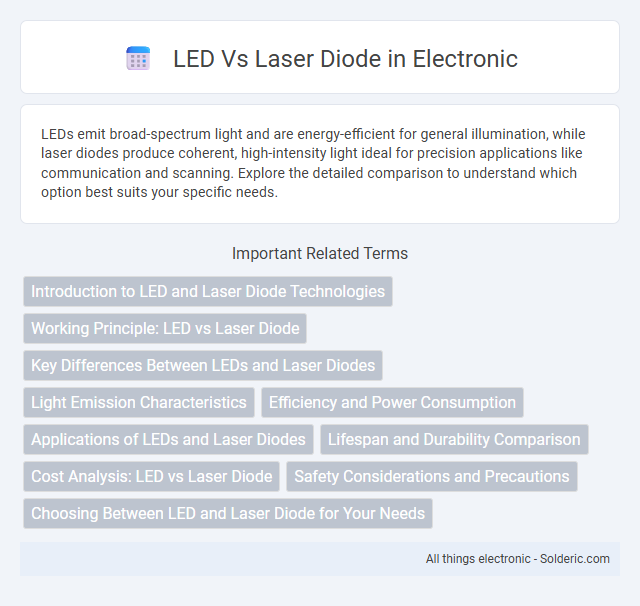LEDs emit broad-spectrum light and are energy-efficient for general illumination, while laser diodes produce coherent, high-intensity light ideal for precision applications like communication and scanning. Explore the detailed comparison to understand which option best suits your specific needs.
Comparison Table
| Feature | LED (Light Emitting Diode) | Laser Diode |
|---|---|---|
| Light Emission | Incoherent, broad spectrum | Coherent, monochromatic |
| Beam Type | Divergent, wide angle | Focused, narrow angle |
| Power Efficiency | Moderate | High |
| Intensity | Lower intensity | High intensity |
| Applications | Indicators, lighting, displays | Optical communication, scanning, medical devices |
| Cost | Lower cost | Higher cost |
| Lifetime | Longer lifespan | Moderate lifespan |
| Modulation Speed | Lower speed | High speed |
| Temperature Sensitivity | Less sensitive | More sensitive |
Introduction to LED and Laser Diode Technologies
LEDs (Light Emitting Diodes) emit light through electroluminescence, where electrons recombine with holes in a semiconductor material, producing incoherent light primarily used for indicator lights and displays. Laser diodes generate coherent, monochromatic light by stimulated emission in a semiconductor laser cavity, offering high intensity and directionality for applications such as fiber-optic communications and laser printing. Both technologies leverage semiconductor materials but differ fundamentally in light coherence, emission spectrum, and application scope.
Working Principle: LED vs Laser Diode
LEDs operate by electroluminescence, where electrons recombine with holes in a semiconductor material, emitting incoherent light in multiple directions. Laser diodes rely on stimulated emission within a resonant cavity, producing coherent, monochromatic light with a narrow beam. The fundamental difference lies in the laser diode's optical feedback mechanism, which amplifies light intensity and coherence, unlike the spontaneous emission in LEDs.
Key Differences Between LEDs and Laser Diodes
LEDs emit incoherent, broad-spectrum light through spontaneous emission, while laser diodes produce coherent, narrow-spectrum light via stimulated emission. LEDs typically have lower brightness and efficiency compared to laser diodes, which offer higher intensity and directional output ideal for precise applications. Understanding these key differences helps you select the right light source for tasks requiring either general illumination or focused, high-intensity beams.
Light Emission Characteristics
LEDs emit incoherent, broad-spectrum light with a wide beam angle, making them ideal for general illumination and indicator applications. Laser diodes produce coherent, monochromatic light with a narrow beam divergence, enabling high precision in communication, medical, and industrial uses. The differences in emission characteristics arise from the distinct physical processes: spontaneous emission in LEDs versus stimulated emission in laser diodes.
Efficiency and Power Consumption
Laser diodes exhibit higher efficiency and lower power consumption compared to LEDs due to their coherent light emission and narrow spectral output. Your choice of laser diode can deliver precise illumination with reduced energy wastage, making them ideal for applications requiring focused beams and minimal heat generation. LEDs typically consume more power as they emit incoherent, broad-spectrum light, resulting in lower luminous efficiency.
Applications of LEDs and Laser Diodes
LEDs find extensive use in general lighting, display screens, and indicator lights due to their energy efficiency, long lifespan, and broad spectrum emission. Laser diodes are crucial in applications requiring coherent light sources, such as optical communication, laser printers, barcode scanners, and medical devices. Choosing between these technologies depends on your need for either broad-area illumination or high-precision, focused light.
Lifespan and Durability Comparison
Laser diodes generally offer a longer lifespan, often exceeding 20,000 hours, compared to LEDs, which typically last around 25,000 to 50,000 hours but tend to degrade faster under high-stress conditions. Laser diodes exhibit superior durability due to their robust semiconductor construction and precise wavelength output, making them ideal for applications requiring consistent performance over time. When selecting your lighting solution, consider that laser diodes provide greater reliability in demanding environments, while LEDs excel in cost-effectiveness and energy efficiency.
Cost Analysis: LED vs Laser Diode
LEDs generally offer a lower initial cost compared to laser diodes due to simpler manufacturing processes and widespread use in consumer electronics. Laser diodes, while more expensive upfront, provide higher efficiency and longer lifespan, potentially reducing total cost of ownership in high-performance applications. Your choice should balance budget constraints with the specific performance and durability requirements of your project.
Safety Considerations and Precautions
LEDs emit incoherent light at lower power levels, making them generally safer for casual use, while laser diodes produce coherent, high-intensity beams that require strict safety measures to prevent eye damage. Protective eyewear and controlled environments are essential when working with laser diodes to avoid retinal injuries and skin burns. Understanding these safety differences helps you implement proper precautions for each light source in your applications.
Choosing Between LED and Laser Diode for Your Needs
Choosing between LED and laser diode depends on factors like coherence, intensity, and application. LED emits incoherent light with lower intensity, ideal for indicator lights, displays, and simple illumination, while laser diodes produce coherent, high-intensity beams suited for precision tasks such as barcode scanning, fiber optic communication, and laser printing. Consider power consumption, heat generation, and cost efficiency, as LEDs typically offer longer lifespans and lower costs, whereas laser diodes deliver superior performance in high-precision and high-speed applications.
LED vs Laser diode Infographic

 solderic.com
solderic.com